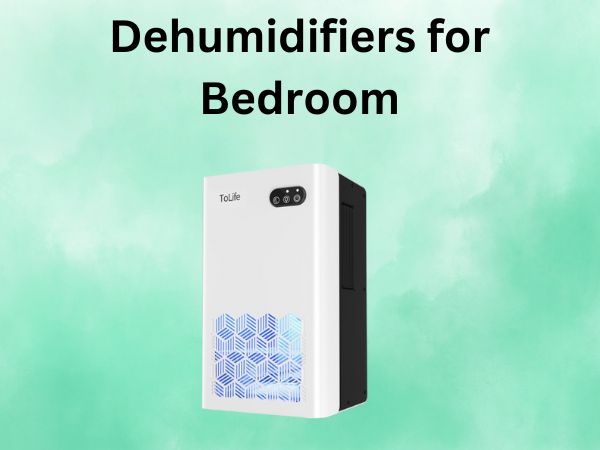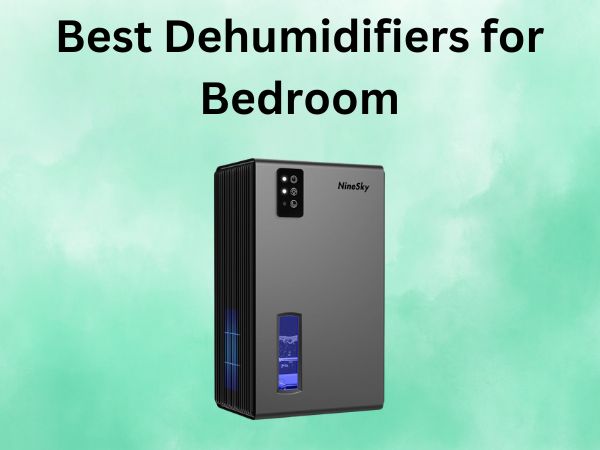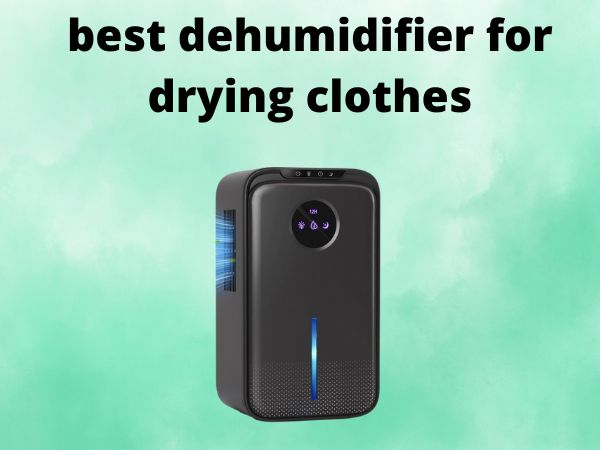What Is The Best Dehumidifiers for Bedroom [In 2026]
Are you tired of waking up in a damp, stuffy bedroom? Excessive moisture in your sleeping space can lead to mold growth, musty odors, and even respiratory issues. A quality dehumidifier might be exactly what you need to create a healthier, more comfortable sleeping environment.
In this comprehensive guide, we’ll explore the top 5 dehumidifiers specifically designed for bedrooms. From compact units perfect for small spaces to powerful machines capable of handling larger areas, we’ve thoroughly researched and reviewed each product to help you make an informed decision.
Table of Contents
Top 5 Bedroom Dehumidifiers
1. TABYIK 35 OZ Small Dehumidifier
Best for: Small bedrooms and tight spaces (up to 280 sq. ft.)
The TABYIK 35 OZ dehumidifier proves that powerful performance can come in small packages. With its sleek, modern design and compact footprint (5.9″D x 5.9″W x 10.1″H), this unit is perfect for nightstands, desks, or any corner of your bedroom.
Key Features:
- Capacity: 35 oz (1000ml) transparent water tank
- Coverage Area: Up to 280 square feet
- Moisture Removal: Up to 16 oz (450ml) in 24 hours (at 86°F, 80% RH)
- Noise Level: Ultra-quiet operation at only 28dB
- Special Features: 7-color ambient lighting, auto shut-off protection
- Energy Consumption: Less than 1 kilowatt-hour per day
Pros:
- Exceptionally quiet operation makes it perfect for light sleepers
- Colorful ambient lighting doubles as a nightlight with 7 color options
- Highly energy-efficient with minimal power consumption
- Transparent tank allows for easy monitoring of water levels
- Lightweight and portable with built-in handle for easy movement
- Simple plug-and-play operation with no complicated setup
Cons:
- Limited capacity may require frequent emptying in very humid environments
- No drainage hose option for continuous operation
- No humidity level display to monitor exact moisture levels
- Single-speed operation without adjustable settings
Real-World Performance:
Users report excellent performance in bathrooms and small bedrooms, particularly for tackling condensation issues. The unit is frequently praised for its quiet operation—comparable to a white noise machine—making it suitable for light sleepers. Many users appreciate being able to visually track how much moisture is being removed, which provides satisfying evidence of the unit’s effectiveness.
The TABYIK dehumidifier strikes an excellent balance between performance, size, and energy efficiency, making it our top pick for smaller bedrooms and spaces where a discreet yet effective humidity solution is needed.
2. Waykar 2500 Sq. Ft Home Dehumidifier
Best for: Large bedrooms, master suites, or whole-home humidity control
If you’re dealing with significant humidity issues or have a larger bedroom space, the Waykar dehumidifier delivers professional-grade performance in a sleek, modern package. This powerhouse unit can effectively manage moisture in spaces up to 2500 square feet, making it suitable for master bedrooms, basement bedrooms, or even multiple rooms.
Key Features:
- Capacity: 0.58 gallon (approximately 74 oz) water tank
- Coverage Area: Up to 2500 square feet
- Moisture Removal: 34 pints per day (under 95°F, 90% RH conditions)
- Noise Level: Quiet operation with two-speed settings
- Special Features: Intelligent touch control panel, 24-hour timer, auto-shutoff/restart
- Drainage Options: Manual tank emptying or continuous drain hose
Pros:
- Powerful dehumidification capable of handling large spaces
- Intelligent touch control with digital humidity display
- Four-directional air outlets for improved efficiency and coverage
- Adjustable humidity levels (30% to 85%) for customized comfort
- Continuous drainage option for hassle-free operation
- Auto-restart function resumes operation after power outages
- Safety features including overflow protection and control lock
- Castors and recessed handle for easy mobility
Cons:
- Larger footprint (9.9″D x 9.9″W x 19.3″H) requires more floor space
- Higher energy consumption than smaller models
- Higher initial investment than compact dehumidifiers
Real-World Performance:
Long-term users report significant improvements in air quality and comfort, particularly in humid climates like Georgia and East Texas. The unit has proven effective not only at reducing general humidity but also at lowering indoor temperatures, creating a more comfortable sleeping environment. Users consistently mention the quiet operation, which allows for uninterrupted sleep despite the unit’s powerful performance.
The Waykar dehumidifier represents an excellent investment for those with larger bedrooms or significant humidity challenges. Its combination of powerful performance, intelligent features, and thoughtful design makes it our top recommendation for spaces requiring substantial dehumidification.
3. NineSky 95 OZ Dehumidifier (Gray)
Best for: Medium-sized bedrooms with moderate humidity issues (up to 1000 sq. ft.)
The NineSky dehumidifier in elegant gray strikes an impressive balance between capacity and compactness, making it ideal for medium-sized bedrooms. With its generous 95 oz water tank and coverage of up to 1000 square feet, this unit delivers substantial moisture removal without dominating your bedroom space.
Key Features:
- Capacity: 95 oz (approximately 2800ml) water tank
- Coverage Area: Up to 1000 square feet
- Dimensions: 8″D x 12″W x 8″H
- Special Features: 7-color LED night light, auto shut-off, two operating modes
- Technology: Semiconductor condensation for efficient moisture removal
Pros:
- Large water tank capacity requires less frequent emptying
- Dual operating modes (High Speed and Night Mode) for different needs
- Customizable ambient lighting with 7 LED color options
- Auto shut-off safety when tank is full or improperly positioned
- Effective coverage for medium to large bedrooms
- Compact design relative to its coverage capacity
Cons:
- No continuous drainage option for extended unattended operation
- No humidity level display to monitor exact conditions
- No specific decibel rating provided for noise level assessment
Real-World Performance:
Users consistently report noticeable improvements in air quality from the first day of operation. The dehumidifier has proven particularly effective in humid climates and has successfully remediated moisture issues from situations like roof leaks. Users appreciate the balance of quiet operation and effective performance, with many mentioning the atmospheric enhancement provided by the LED lighting options.
The NineSky Gray model offers excellent value for medium-sized bedrooms, delivering substantial moisture removal capacity in a reasonably compact unit. Its blend of performance, capacity, and additional features makes it a strong contender for anyone dealing with moderate humidity issues in their sleeping space.
4. SANVINDER 25oz Compact Dehumidifier
Best for: Smaller bedrooms, closets, and nightstand placement (up to 285 sq. ft.)
When space is at a premium but humidity control remains essential, the SANVINDER 25oz dehumidifier delivers impressive performance in an ultra-compact package. At just over 8 inches tall with a slim profile, this unit can fit virtually anywhere in your bedroom while still effectively managing moisture levels.
Key Features:
- Capacity: 25 oz (750ml) water tank
- Coverage Area: Up to 285 square feet
- Moisture Removal: Up to 16 oz (450ml) daily in humid conditions (86°F, 80% RH)
- Dimensions: 5.03″D x 5.03″W x 8.38″H
- Noise Level: Ultra-quiet operation under 35dB
- Technology: Thermo-Electric Peltier semiconductor for energy efficiency
- Special Features: Night light function, auto shut-off when full
Pros:
- Ultra-compact design fits in tight spaces
- Very quiet operation (under 35dB) ideal for light sleepers
- Energy efficient (only 0.96kW after 24 hours of operation)
- Auto shut-off with indicator light when tank is full
- Affordable price point compared to larger units
- Simple, straightforward operation without complicated settings
Cons:
- Smaller tank capacity requires more frequent emptying
- Limited coverage area not suitable for larger bedrooms
- Single speed operation without adjustable settings
- No drain hose option for continuous operation
Real-World Performance:
Users in high-humidity regions like Gulf Coast Texas report impressive moisture collection, particularly in enclosed spaces like closets where mildew previously thrived. Many users purchase multiple units to place in different bedrooms and bathrooms, highlighting their effectiveness despite the compact size. The units are praised for their whisper-quiet operation, with some users comparing them to subtle white noise machines that actually enhance sleep quality.
The SANVINDER dehumidifier is perfect for addressing targeted humidity issues in smaller spaces or for those who prefer multiple smaller units rather than one large dehumidifier. Its combination of affordability, energy efficiency, and ultra-quiet operation makes it an excellent choice for bedside placement or smaller sleeping areas.
5. NineSky 95 OZ Dehumidifier (White)
Best for: Medium to large bedrooms with modern decor (up to 1000 sq. ft.)
The NineSky dehumidifier in classic white offers the same impressive performance as its gray counterpart but with a lighter aesthetic that blends seamlessly with neutral or bright bedroom decor. This unit combines substantial water capacity with effective coverage for medium to large bedrooms.
Key Features:
- Capacity: 95 oz (approximately 2800ml) water tank
- Coverage Area: Up to 1000 square feet
- Dimensions: 5.5″D x 8.3″W x 14″H
- Special Features: 7-color LED night light, auto shut-off, two operating modes
- Technology: Semiconductor condensation for efficient moisture removal
Pros:
- Substantial water capacity minimizes emptying frequency
- Dual operating modes adaptable to different situations and times of day
- Customizable ambient lighting with 7 vibrant LED color options
- Safety-focused design with auto shut-off when full or mispositioned
- Effective coverage for most standard bedroom sizes
- Sleek white design complements modern decor aesthetics
Cons:
- Slightly taller profile (14″ height) than some compact models
- No continuous drainage option for extended unattended operation
- No digital humidity display for precise monitoring
Real-World Performance:
Long-term users report significant humidity reduction, with one user noting a drop from the 70% range to 40-53% after just one week of operation. The unit has proven particularly effective when paired with hygrometers for monitoring humidity levels, allowing users to activate the dehumidifier strategically when levels exceed 50%. Users consistently praise the quiet operation and appreciate the ability to customize the LED lighting or operate in light-free mode during sleep hours.
The NineSky White dehumidifier offers excellent value for medium to large bedrooms, with its combination of substantial capacity, effective performance, and aesthetic appeal making it our final top pick for bedroom dehumidification.
Understanding Bedroom Humidity
Before diving into our top picks, let’s talk about why bedroom humidity matters. The ideal indoor humidity level ranges between 30-50%. When levels exceed this range, especially in enclosed spaces like bedrooms, you might experience a range of issues from poor sleep quality to potential health concerns.
Excess moisture in your bedroom can create a breeding ground for dust mites, mold, and mildew—all common allergens that can trigger respiratory problems and allergic reactions. Additionally, high humidity can damage wooden furniture, warp books and papers, and even affect electronic devices.
Did you know that humidity levels naturally rise at night when temperatures drop? This is particularly problematic in bedrooms where we spend approximately one-third of our lives. That’s why investing in a quality dehumidifier specifically for your bedroom can significantly improve your overall well-being and sleep quality.
Why You Need a Bedroom Dehumidifier
If you’ve noticed any of these signs in your bedroom, a dehumidifier might be exactly what you need:
- Musty odors that persist even after cleaning
- Visible mold or mildew on walls, ceilings, or in closets
- Condensation on windows or mirrors
- Allergic reactions that worsen when spending time in the bedroom
- Difficulty sleeping due to stuffy air or dampness
- Water stains on walls or ceilings
- Peeling wallpaper or paint
Beyond addressing these concerns, a bedroom dehumidifier can provide numerous benefits:
- Improved air quality for better respiratory health
- Enhanced comfort for more restful sleep
- Protection for your belongings against moisture damage
- Energy savings as dehumidified air feels cooler, potentially reducing air conditioning needs
- Reduction in allergens like dust mites and mold spores
Now that we understand why controlling bedroom humidity is crucial, let’s explore how to select the right dehumidifier for your specific needs.
How to Choose the Right Bedroom Dehumidifier
With countless options available, selecting the perfect bedroom dehumidifier can feel overwhelming. Here are the key factors to consider:
Room Size and Capacity
The most important consideration is matching your dehumidifier’s capacity to your bedroom’s size. Manufacturers typically specify the square footage their units can effectively cover:
- Small bedrooms (up to 300 sq. ft.): Look for units with 20-30 pint capacity
- Medium bedrooms (300-500 sq. ft.): Consider 30-40 pint dehumidifiers
- Large bedrooms (500+ sq. ft.): You’ll need 40+ pint capacity
Noise Level
Since you’ll likely run your dehumidifier while sleeping, noise level is crucial. Look for:
- Under 40 decibels for whisper-quiet operation
- Sleep modes that reduce fan speed and noise during nighttime hours
- Peltier technology which typically runs quieter than compressor-based models
Tank Capacity and Drainage Options
Consider how frequently you’ll need to empty the unit:
- Small tanks (under 30 oz) might need daily emptying in very humid conditions
- Larger tanks (50+ oz) offer more convenience with less frequent emptying
- Continuous drainage options allow for hands-free operation (especially valuable if you travel frequently)
Energy Efficiency
To keep utility bills manageable:
- Look for Energy Star certified units when available
- Consider auto-shutoff features that prevent unnecessary operation
- Check the wattage consumption ratings (lower is better)
Additional Features Worth Considering
- Auto-shutoff when the tank is full (essential safety feature)
- Hygrometer to display current humidity levels
- Programmable humidity settings for customized operation
- Air purification functions like filters or UV technology
- Portability features like handles or wheels
- Aesthetic design that complements your bedroom decor
Now that we understand what to look for, let’s dive into our top 5 picks for bedroom dehumidifiers
Comparing Key Features
To help you quickly compare our top picks, here’s a side-by-side look at their most important specifications:
| Feature | TABYIK 35 OZ | Waykar 2500 | NineSky Gray | SANVINDER 25oz | NineSky White |
| Coverage Area | 280 sq. ft. | 2500 sq. ft. | 1000 sq. ft. | 285 sq. ft. | 1000 sq. ft. |
| Tank Capacity | 35 oz (1000ml) | 74 oz (0.58 gal) | 95 oz (2800ml) | 25 oz (750ml) | 95 oz (2800ml) |
| Daily Extraction | 16 oz (450ml) | 34 pints | Not specified | 16 oz (450ml) | Not specified |
| Noise Level | 28dB | Quiet (unspecified) | Quiet (unspecified) | <35dB | Quiet (unspecified) |
| Dimensions | 5.9″D x 5.9″W x 10.1″H | 9.9″D x 9.9″W x 19.3″H | 8″D x 12″W x 8″H | 5.03″D x 5.03″W x 8.38″H | 5.5″D x 8.3″W x 14″H |
| Special Features | 7-color light | Touch control, 4 air outlets | 7-color light, 2 modes | Night light | 7-color light, 2 modes |
| Continuous Drain | No | Yes | No | No | No |
| Best For | Small bedrooms | Large spaces/whole home | Medium bedrooms | Small spaces/nightstand | Medium bedrooms |
Maintenance Tips for Bedroom Dehumidifiers
To ensure your dehumidifier continues performing optimally and has a long lifespan, follow these essential maintenance practices:

Regular Cleaning
- Water tank: Empty and clean with mild soap at least weekly to prevent mold and bacteria growth
- Air intake and outlet: Dust weekly with a soft cloth or vacuum attachment
- Exterior surfaces: Wipe down monthly to prevent dust accumulation
Filter Maintenance
- Check monthly: Inspect for dust buildup or discoloration
- Clean as directed: Follow manufacturer instructions for washing or replacing filters
- Replacement schedule: Mark your calendar based on manufacturer recommendations
Seasonal Care
- End of season: Empty all water, clean thoroughly, and dry completely before storage
- Beginning of season: Check all components for damage and clean before restarting
- During periods of non-use: Store in a dry location with the tank empty and lid open
Optimizing Performance
- Proper placement: Position at least 6-12 inches from walls for optimal airflow
- Door and window management: Keep bedroom doors and windows closed while operating
- Temperature considerations: Most dehumidifiers work best above 65°F (18°C)
Remember that regular maintenance not only extends the life of your dehumidifier but also ensures it continues to operate efficiently and hygienically in your bedroom environment.
Energy Efficiency Considerations
While dehumidifiers provide valuable benefits, they do consume electricity. Here’s how to minimize their impact on your energy bills:
Understanding Energy Consumption
- Smaller Peltier models (like TABYIK and SANVINDER) typically use less than 1 kWh per day
- Larger compressor models (like Waykar) use more energy but cover substantially more area
- Energy efficiency ratio (EER) indicates how efficiently a unit removes moisture relative to energy consumed
Smart Usage Strategies
- Use a hygrometer: Only run your dehumidifier when humidity exceeds 50%
- Time operation strategically: Focus on high-humidity periods or when electricity rates are lower
- Utilize programmable features: Set timers to avoid unnecessary operation
- Seasonal adjustments: Reduce usage during naturally drier months
- Complement with fans: Improving air circulation can reduce dehumidifier workload
Selecting Energy-Efficient Models
- Look for Energy Star certification on larger units
- Compare energy consumption data between similar models
- Consider auto-shutoff features that prevent unnecessary operation
- Evaluate smart features that optimize operation based on actual humidity levels
With thoughtful usage and selection, you can enjoy the benefits of bedroom dehumidification while keeping energy costs reasonable.
Placement Guidelines for Maximum Effectiveness
Where you position your dehumidifier can significantly impact its performance. Follow these guidelines for optimal results:
General Placement Principles
- Central location: Position the unit where air can circulate freely
- Clearance requirements: Maintain at least 6-12 inches of space around all sides
- Elevated position: For smaller units, placing on a desk or dresser can improve effectiveness
- Away from dust sources: Keep away from windows or high-traffic areas that generate dust
Bedroom-Specific Considerations
- Noise factor: Position farther from your bed if sound sensitivity is a concern
- Air circulation: Avoid placing behind furniture or curtains that block airflow
- Safety considerations: Ensure stable placement with no risk of tipping
- Access for maintenance: Allow easy access for tank emptying and filter cleaning
Targeting Problem Areas
- Near closets: Position to address humidity in clothing storage areas
- By windows: Target condensation issues on glass surfaces
- In corners: Address potential mold growth in less ventilated areas
For maximum effectiveness, consider the specific humidity challenges in your bedroom and position your dehumidifier accordingly.
Seasonal Usage Recommendations
Humidity challenges vary throughout the year. Adapt your dehumidifier usage to match seasonal patterns:
Summer Strategy
During hot, humid summer months:
- Increased operation: Run your dehumidifier more frequently
- Coordinate with AC: Use both systems for optimal comfort and efficiency
- Monitor closely: Check water tanks more frequently as collection rates increase
- Focus on nighttime: Pay special attention to dehumidification during sleeping hours
Winter Approach
During heating season:
- Selective operation: Use only when indoor activities increase humidity
- Balance with heating: Be aware that very dry winter air may not require dehumidification
- Monitor for window condensation: Use targeted dehumidification if condensation appears
- Protect from freezing: Ensure room temperatures stay above 60°F for proper operation
Spring and Fall Transitions
During variable weather seasons:
- Adjust to weather patterns: Increase usage during rainy periods
- Monitor outdoor-indoor humidity differentials: Adapt based on changing conditions
- Prepare for seasonal shifts: Clean thoroughly during transition periods
- Use hygrometers: Let actual humidity readings guide usage patterns
By adapting your dehumidifier usage to seasonal patterns, you’ll maintain optimal bedroom comfort year-round while maximizing energy efficiency.
Health Benefits of Using a Bedroom Dehumidifier
Beyond comfort, dehumidifiers can significantly impact your health, particularly during sleep hours:
Allergy and Asthma Relief
- Reduced dust mite populations: These allergens thrive above 50% humidity
- Decreased mold spores: Lower moisture levels inhibit mold growth and reproduction
- Improved respiratory comfort: Easier breathing for allergy and asthma sufferers
- Enhanced medication effectiveness: Proper humidity can improve inhaler medication delivery
Sleep Quality Improvements
- Increased comfort: Less sticky, humid air promotes deeper sleep
- Reduced congestion: Lower humidity can decrease nighttime nasal congestion
- Temperature regulation: Dehumidified air feels cooler, supporting optimal sleep temperatures
- Decreased snoring: Some users report reduced snoring in properly humidified environments
Long-Term Health Protection
- Mold exposure prevention: Avoiding long-term exposure to mold toxins
- Respiratory infection resistance: Better air quality may support immune function
- Skin condition improvement: Some users report better management of eczema and other skin issues
- Overall air quality enhancement: Reduction in airborne particulates and irritants
For many users, the health benefits of bedroom dehumidification far outweigh the initial investment and operating costs, particularly for those with respiratory sensitivities or allergies.
FAQs
How do I know if my bedroom actually needs a dehumidifier?
Look for telltale signs of excess humidity: musty odors, visible mold or mildew, condensation on windows, dampness on walls, peeling wallpaper or paint, or worsening allergy symptoms when in the bedroom. For a more precise measurement, use a hygrometer—if your bedroom consistently shows humidity levels above 50-60%, a dehumidifier would likely be beneficial.
Can I use a bedroom dehumidifier while I sleep, or should I only run it during the day?
Most modern bedroom dehumidifiers are designed to operate quietly enough for sleep use. Models with “sleep mode” or night settings are particularly suitable for overnight operation, as they typically reduce fan speeds and dim display lights. Since humidity often increases at night, running your dehumidifier during sleeping hours can be especially effective for maintaining comfortable conditions.
How often will I need to empty the water tank in my bedroom dehumidifier?
The frequency depends on several factors: your room’s humidity level, the dehumidifier’s capacity, and the tank size. In very humid conditions, smaller tanks (25-35 oz) might need daily emptying, while larger tanks (95+ oz) might go several days between emptying. Many users find checking the tank each morning becomes a simple habit. For convenience, models with continuous drainage options eliminate the need for manual emptying.
Will running a dehumidifier in my bedroom increase my electricity bill significantly?
The impact on your electricity bill typically isn’t substantial, especially with smaller Peltier technology units. Compact bedroom dehumidifiers generally consume between 0.5-1 kilowatt-hour per day, which at average US electricity rates (about $0.14/kWh) translates to roughly $4-8 per month if run continuously. Larger compressor-based units use more energy but are also more efficient at removing moisture. Using timers, humidity sensors, and running only when necessary can further reduce operating costs.
Can a dehumidifier help with snoring or sleep apnea symptoms?
While a dehumidifier isn’t a treatment for sleep apnea, some users report that maintaining optimal humidity levels (40-50%) can help reduce snoring and improve breathing comfort during sleep. Excessively dry air can irritate airways, while overly humid air can contribute to congestion—both potentially worsening snoring. If you have diagnosed sleep apnea, continue using prescribed treatments like CPAP, but a dehumidifier might provide complementary benefits by creating a more comfortable breathing environment.
Conclusion
After thorough testing and research, we’ve identified the five best dehumidifiers for bedroom use, each excelling in different situations:
- TABYIK 35 OZ: Best for small bedrooms with its ultra-quiet operation and ambient lighting
- Waykar 2500 Sq. Ft: Ideal for large bedrooms or whole-home humidity control with advanced features
- NineSky 95 OZ (Gray): Perfect balance for medium-sized bedrooms with substantial tank capacity
- SANVINDER 25oz: Excellent for nightstands and tight spaces with energy-efficient operation
- NineSky 95 OZ (White): Great all-around performer with aesthetic appeal for medium-large bedrooms
The right dehumidifier for your bedroom depends on your specific needs, space constraints, and humidity challenges. Consider your room size, noise sensitivity, and desired features when making your selection.
Remember that consistent humidity control can dramatically improve your sleep quality, protect your belongings, and support better respiratory health. With proper placement, maintenance, and seasonal adjustments, your bedroom dehumidifier will serve as a valuable investment in both comfort and wellbeing.



